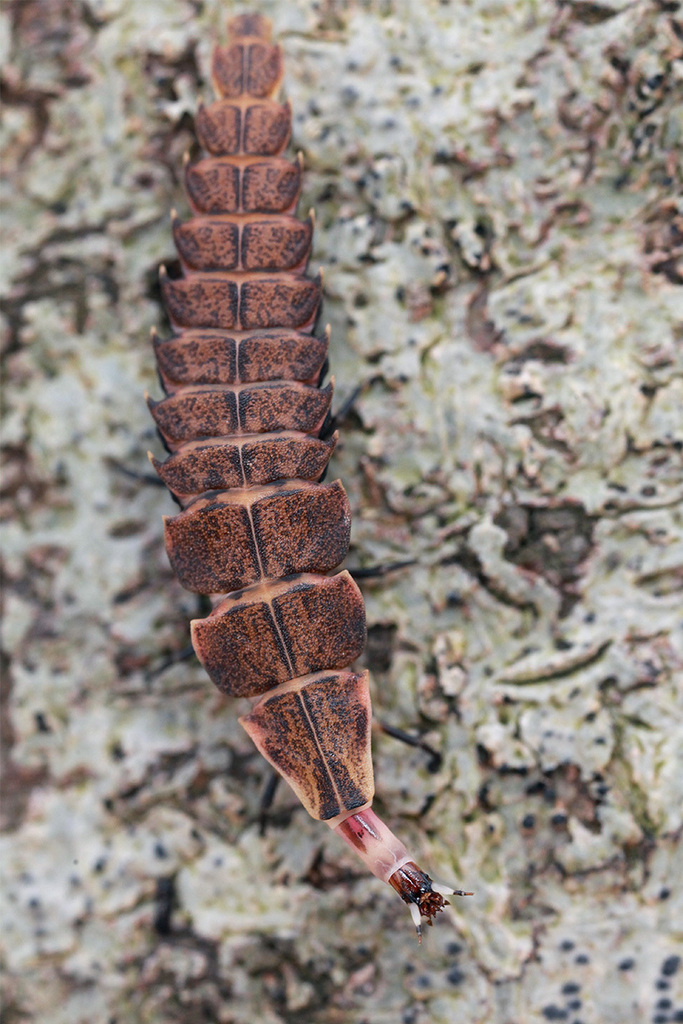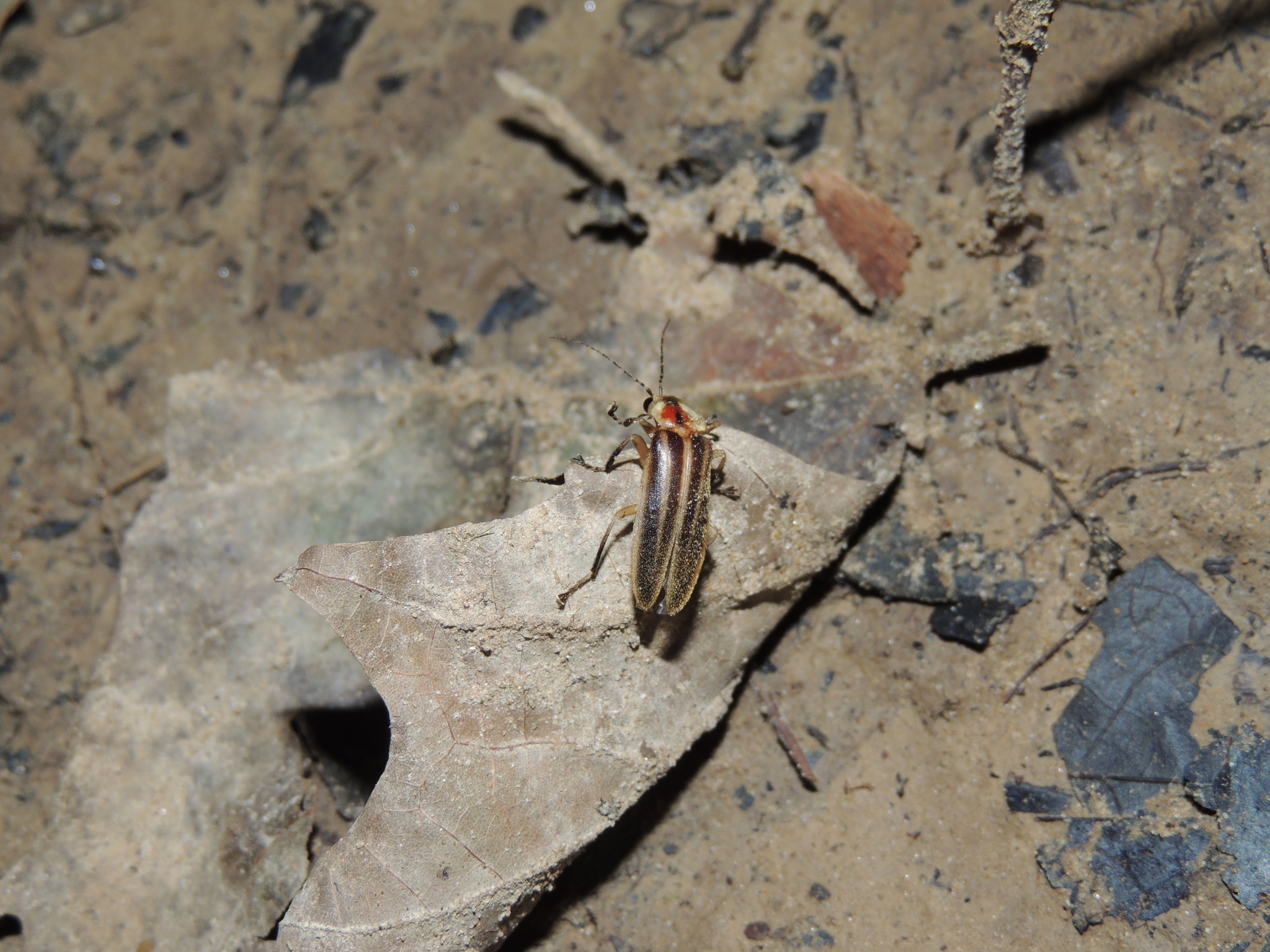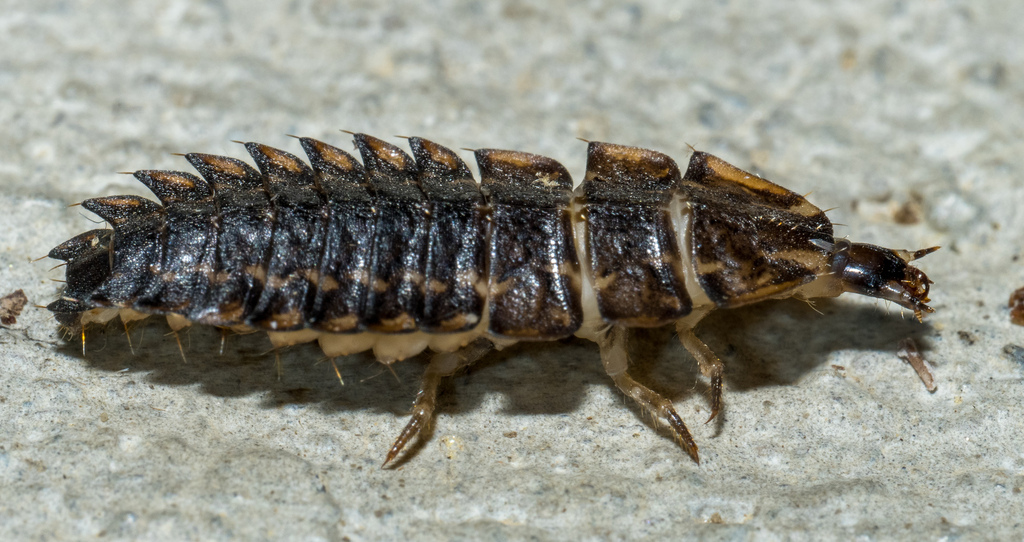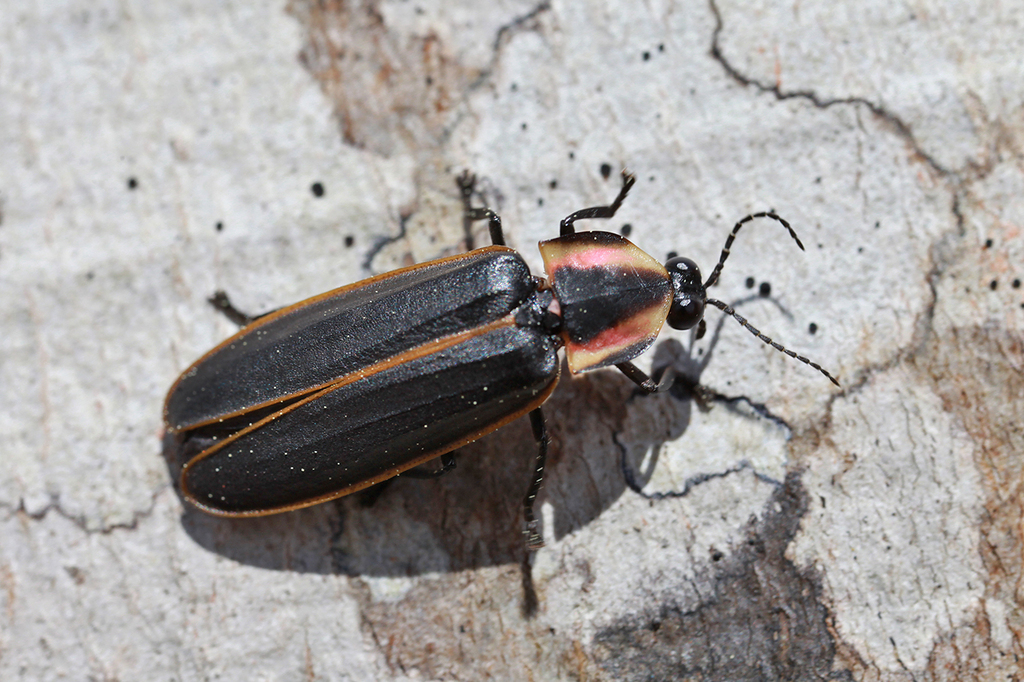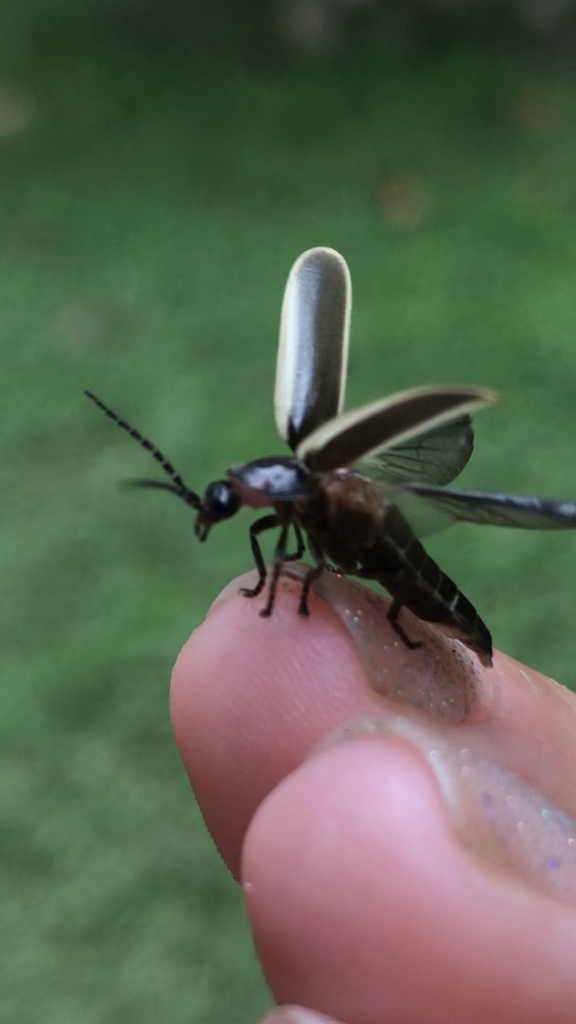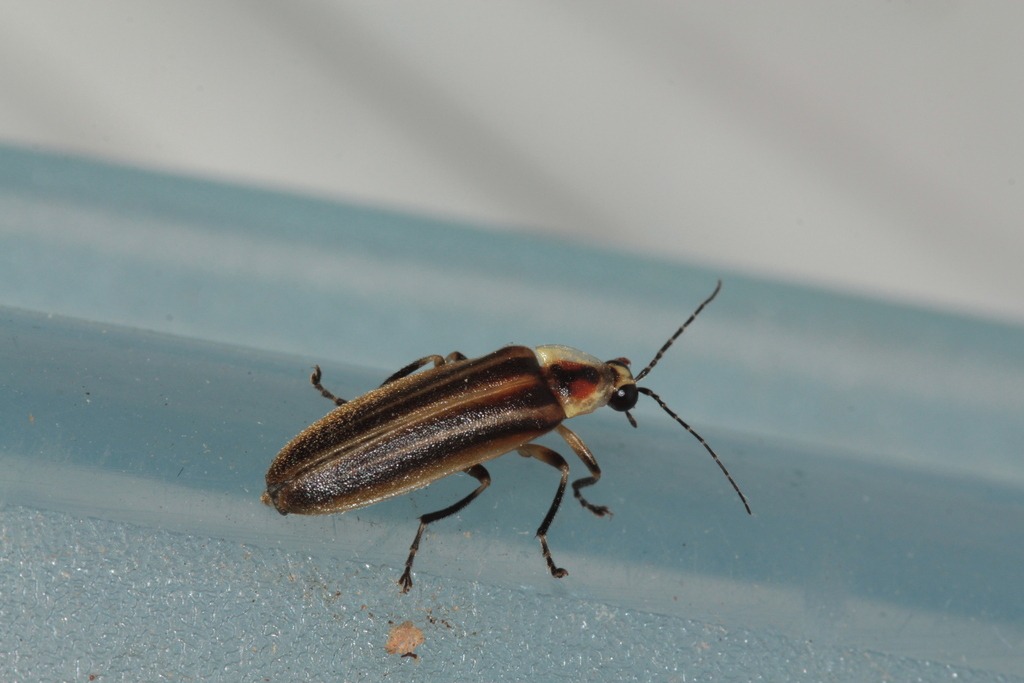Few insects are more beloved than fireflies (Coleoptera: Lampyridae). They're charismatic little beetles that glimmer in the dark, will land on your hands at night, and can be viewed in mason jars for the pleasure of children and adults alike. They're so captivating that, in many areas of the USA, summer fireflies are nearly synonymous with childhood nostalgia (despite the fact that many adult fireflies don't actually glow!).
However, these nighttime flashers are in trouble. If you've heard of the "insect apocalypse", you've likely heard that light pollution and urbanization are threatening fireflies. That's probably true, and there are other factors at play as well. To conserve the fireflies, we need to understand what else is going on.
On this page, there will be some general information; I'm also focusing especially on the genus Photuris. The species P. frontalis, also known as the Snappy Single Sync, is fairly unique! Males will aggregate and flash in synchrony. We have them here in South Carolina, and you can enter a lottery to go see them in Congaree National Park in the summer.
There are 3 species of synchronous fireflies known in North America -- Photinus carolinus in the Smokies, Photuris frontalis around Congaree, and Photinus knulli in Arizona. Some other species are in the Eastern hemisphere, but those are the ones we have here. Photinus is interesting, but not my main focus here; suffice it to say that they're somewhat easier to study than Photuris, and better known.
A quick diversion for some background information on species distinction: the current "gold standard" in taxonomy is to use a combination of morphological (what does the beast look like?) and molecular (what genes does the beast have?) data. These are characters that can be discerned from dead specimens, and sometimes even long-dead ones, depending how they were killed and preserved. If you have a cabinet full of pinned specimens, you've probably got what you need.
However, Photuris spp. aren't really visually distinct. And, so far as I can tell, nobody's really done DNA on them. The features that separate the species of Photuris from each other aren't morphological (not even the male genitalia -- aedeagi -- as in many beetles), they're behavioral. Flash patterns are used by the adults to find mates and possibly avoid predation, as they are often distasteful. The flashing can signal to potential attackers that this isn't good eatin'. Experienced bats will actually avoid flashing fireflies! For intraspecific purposes, though, flashes are for reproduction. If the flash patterns aren't correct, the insects won't mate.
Now, if you're not a taxonomist or ecologist, you may not be super familiar with different species concepts. Most of us learn in high school and intro bio that a species is defined as a group of organisms that can mate and produce viable offspring. But, as with just about everything in biology, things aren't quite that simple. Like I said, Photuris spp. are behaviorally delineated. They probably COULD mate and produce viable offspring, but because of their mating requirements, they're essentially reproductively isolated.
This is all relevant to Photuris spp. because it is impossible to discern flash patterns from preserved specimens. So the species differences are poorly known, the larvae (which live in leaf litter) even more so, and life history data seem to be scarce and probably unreliable.
This is all relevant to this page in particular because, if we want to conserve them, we need to know some basic things about them. Things like "what conditions do their larvae prefer?", "what's their main prey?" (in general, firefly larvae are predatory), "how long do they take to complete their life cycle, and how much of that time is spent as a larva vs as an adult?", etc.
You'll notice that the questions I've listed there pertain to the larvae more than the adults. This is because many insects spend much longer in their juvenile than adult stages, and it doesn't matter if you have ideal conditions for adults to find each other if the larval habitat isn't there!
So, what is it that their larvae need?
Per McLean et al 1972, larvae are most abundant in well-shaded moist areas and uncommon in open fields or thick forest. Apparently "larvae shrivel up and die in a few hours if left in a dry container at room temperature" and "even large larvae cannot endure dry conditions for more than an hour or two and small larvae shrivel in minutes," so humidity must be very important. Around Maryland, Photuris spp. pupate in May and June; this may be much different in other environments. McLean et al note also that it's very likely that the creatures have two broods per year. Each brood seems to require one full and one partial growth season plus two winter dormancies to fully mature and eclose as an adult in spring. This gives the larvae a general lifespan of 22-24 months, which "agrees with the deductions of (other workers)."
It's generally agreed that larvae of Photuris spp. are predatory on snails and soft-bodied insects, and Buschman 1984 notes that they are also scavengers and will feed on a variety of non-animal/non-living items, such as cut-up insects, gelatin, or grapes. He mentions that the larvae seem to be "very sensitive to the odor of injured caterpillars... when an uninjured caterpillar was placed with a group of larvae they paid little attention to it until it was injured... then many larvae converged on the caterpillar and joined in the feast". Arnett 2002 also places Photuris larvae in a role of omnivorous scavenger.
Per Keiper and Solomon 1972, "larvae of Photuris pennsylvanica thrive best in loose, well-drained, loamy soil... the greatest number of larvae are found in this type of soil." Daily migration from the surface to lower layers of the soil seems to be very important to larval survival (substrates that formed a hard-packed surface or a crust that prevented larval movement resulted in dead larvae), probably due to the aforementioned need for moisture. I haven't determined if this specific soil preference holds true for other species in the genus; as far as I know, Photuris spp. are found in a variety of ecological contexts, so it could well be that other species require different conditions for larval habitat.
Why's this matter? Because suitable habitats are vanishing as wetlands are drained and paved for urban and suburban development. You may have seen stickers that say "No Wetlands, No Seafood". This is true! I'd add on to that: "No Wetlands, Less Fireflies". It isn't entirely accurate to say no fireflies, but Photuris frontalis especially require that kind of damp, vegetated habitat. They need the moisture for their survival, and they need the vegetation for their adults and their prey.
And, as the habitats get drier, fire ants can move in. Anecdotally, areas with fire ants have few to no firefly larvae. Larry Buschman told me that 50 years ago, when he did his dissertation, Florida was chock full of Photuris. Now, when he goes back, he sees fire ants everywhere and the fireflies have just about vanished. This is likely a two-pronged problem: fire ants may directly compete with firefly larvae for other prey, and they probably treat the larvae as more prey. As anyone who's lived near fire ants can tell you, those nests get LARGE and contain many mouths to feed. The more ants there are, the more hunting they need to do. If fireflies are among their prey, that can get dicey.
Larvae are important, but we need to consider the adults, too. All of the life stages are important if we want to keep these creatures around. (For this page, I'm not going over pupae, because they're not running around. They're quietly metamorphosing in chambers in the soil.)
The main things that affect adults are pesticides and light pollution. Most fireflies, at least here in the eastern USA, rely on flashing to find mates: the male advertises a species-specific pattern, the female responds in kind, and they duet as he approaches. If the female can't see the advertising, she won't respond. If the male can't see a response, he won't head towards a mate. This presents problems when fireflies live around urban or suburban areas, because even a little bit of light from houses or streetlamps can severely disrupt their communication.
Insecticides are also a large factor in the health of both larvae and adults. Pesticide runoff from agriculture usually takes most of the blame for insecticides loose in the environment; I'd bet that, if you've heard about pesticides in the environment, farms have been implicated. However, agriculture isn't the only culprit.
A farmer needs to take classes and apply for a license to use most of those chemicals, and they have an economic incentive to use as little as possible: farming doesn't make huge money, and those pesticides get real expensive real fast when they've got massive acreages to cover. I as a homeowner, however, can go to a store and buy a 5-gallon jug of almost the same stuff (in at least some cases, exactly the same stuff). I can buy as many as I want! And I can put as much as I want onto my lawn and my garden. Suburban lawns are a huge contributing factor to pesticide and fertilizer runoff (there's an article from the Oklahoma State Extension Service in the sources below), especially when sprinklers are used to keep the yard green.
Another chemical culprit: bug spray. People don't generally think about where they're spraying their cans of Off!. They're about to go for a hike, they want to set up their tent, they're going to a lakeside potluck, and they don't want mosquito bites. But not all of that repellant goes onto the skin and clothes that they're spraying. Especially from an aerosol can (as opposed to a spray bottle), lots of it just wafts away in the air. That mist can land on plants, and then when a bug comes by, it's exposed to that residue.
Even if the bug doesn't eat any of the plant, a lot of repellants work on contact rather than ingestion: you don't want your bug spray to work only after the mosquito bites you! In addition to coating the plant, the spray can also directly hit the bugs. I was on a field trip, and I took some pictures of a really pretty beetle on a leaf. As I walked away, the guy behind me took out a can of bug spray and used it on his arms, right next to the plant. You don't have to forego the Off! entirely, but a little forethought goes a long way here!
As I mentioned above, fireflies are probably in trouble. Light pollution disrupts their mating; fire ants (most likely) compete with their larvae; increasing urbanization encroaches on their habitats; careless tourists trample them when they go to see the synchronizing flashes in the summer... the list goes on.
("Tourists? What do you mean, careless tourists?" Well, remember how I said that you can enter a lottery to go see them flashing? If you do, and you win, that's great! I hope you have tons of fun. But please keep in mind that these habitats and animals are very vulnerable to being flattened. If you go, be respectful, stay on trail, and listen to the rangers that are there to protect you and the fireflies both. One person stepping off the trail may not seem like much, but these displays draw thousands of people every year. If even a small fraction of those people think to themselves, "well, I'm just one person, what's the big deal?" then there's hundreds of people in the leaves and the larvae are in danger. Now, back to the topic at hand.)
Well, okay, they might need help. But why do we care? They're just bugs, after all. So maybe my grandkids won't get to see flashes in the night. That would suck, but really all that's missing is the nostalgia factor, right? Well...
Here's the thing. "Bugs" as a general category are incredible middlemen in the complex trophic interactions of ecosystems. Stonefly larvae in mountain headwaters shred fallen leaves into smaller particles, which drift downstream to feed mayfly larvae and molluscs. Mayfly larvae are hunted and eaten by trout and bass, and then nice people on the river catch the trout and bass so they can have fun with their friends and get some good food.
In a terrestrial scene, myriapods and isopods wander the forest floor, breaking down dead organic matter and putting those nutrients back into the soil, where trees and grasses can access them. Birds nest in the trees, lizards make their homes in the grasses, and both of those eat whatever bugs happen to pass by.
Dragonflies and ladybugs control crop and garden pests. Mosquitoes, wasps, and beetles (among others) pollinate various plants. Endo- and ectoparasitoids provide population control and food for hyperparasitoids and other predators. Carrion flies and beetles help get rid of dead stuff -- did you know that, all else held equal, a body on dry land will decompose 2x faster than one submerged in water, and 8x faster than one buried in the earth? That's due in large part to the fact that insects can easily access it when it's just placed on the ground.
Without bugs, ecosystems grind to a halt; maybe the fireflies in the weeds aren't the most important part of that category, but we can't ever say for sure that they're not important.
Fireflies also have direct uses to humans. The chemical reaction that they use to light up produces almost no heat, which is extremely unusual. Physicists and chemists are trying to figure out how to replicate that on a larger scale, so that our lights can be more energy-efficient.
In addition to the electrical applications, various bioluminescent compounds (including luciferin and luciferase from fireflies) are used in cancer research; most commonly, the cancer cells are modified slightly to produce luciferin (a protein), then they are implanted in vivo. When researchers want to know the size and development of the tumor, they administer luciferase (an enzyme) to the study animal; the enzyme binds to the protein, catalyzes the light-producing reaction, and the tumor lights up.
Another way that the luciferin-luciferase system is medically useful: anti-cancer drugs are notorious for having severe non-target effects. They're still prescribed, because we think that the benefits of cancer treatment outweigh those negative side effects, but they're definitely sub-optimal. New treatments are constantly under development to try and mitigate those off-target effects so that we can treat cancer in a way that does less damage to the person themselves. Researchers working on a new drug can monitor its spread by adding a luciferase activator onto its molecules and seeing where the light appears. This approach helps us figure out where we need to narrow things down.
Many entomologists, ecologists, and conservationists are aware of the plight of the fireflies, and they aren't sitting idle. Further up this page, I mentioned the firefly viewing lottery -- both Congaree and Great Smoky Mountains National Parks have implemented these lottery systems to allow people to come see the spectacle, without doing too much damage to the animals and the habitats they rely on. Outside of the parks, organizations like the Xerces Society are working to raise awareness about the needs of different kinds of fireflies and the specific dangers they face.
But... is firefly conservation something that can be left up to the policy-makers and researchers?
Absolutely not! In any kind of conservation, community participation is not only desirable, it's essential. In 1910, Gifford Pinchot (a renowned forester) wrote "whatever (the Forest Service) has done or is doing has just one object, and that object is the welfare of the plain American citizen. Unless the Forest Service has served the people, and is able to contribute to their welfare it has failed in its work and should be abolished." He was writing specifically about the early USFS, but his words hold true for conservation in general.
In more recent times, Dr. Louis Jackai of NC State gave a speech at the 2023 annual meeting of the South Carolina Entomological Society. His research focuses on integrated pest management (IPM) in agricultural settings. As he clicked through slides of outreach events, he paused and said to us "we work for the small grower. If what you do in your lab does not help them, if it costs them money, if it doesn't give them measurable benefits that help them stay afloat and competitive, you haven't accomplished anything. You haven't done your job."
That sentiment continues to be emphasized. Drs. Gerry Carner and Eric Benson, professors emeriti at Clemson University, worked internationally in agricultural IPM for many years. They both stress the importance of working with and for the growers, as opposed to working around or above the growers.
Conservation isn't an exact overlap with agriculture or forestry, admittedly. But the principles that they emphasize are still important. Without the understanding, enthusiasm, and cooperation of "regular people", any conservation initiative is destined for failure from the start.
In fact, I would go so far as to say that these ideas are more important in conservation than in many fields -- proper conservation requires getting in there, getting your hands and boots dirty, and working alongside everybody else. Nothing can get done by just decreeing edicts from the comfort of the Capitol and the jingle in a senator's pocket. Laws work only insofar as people agree to be bound. Therefore, those people need to be treated like the equals that they are, rather than obstructions or unlettered rustics.
I say all this to try and make it clear that you can, in fact, help further firefly conservation! Some things you can do:
- Mow your lawn less frequently! Many adult fireflies like tallish grass, and larvae often need noncompacted soil with access to shelter and prey.
- Turn off lights at night! If they have to be on, shield them so that the light is reflected in a narrower radius. A light that just beams out in all directions makes it very difficult for fireflies to find mates.
- Be cautious of where you spray insect repellant! Apply it before you get into the woods, so that the residue is less likely to remain on leaves, trees, and other surfaces where bugs will wander or fly through.
- Leave the leaves! Don't rake and grind up the dead leaves in your lawn in the fall. The Xerces Society has a "leave the leaves" campaign to protect everything from silk moths (like Luna, Cecropia, and Polyphemus moths) to fireflies, because so many creatures depend on that layer of fallen leaves for protection, food, and overwintering purposes. As an added bonus, using leaf litter as mulch can actually help your garden, especially native plants! (Except for leaves from allelopathic trees like red spruce or black walnut, which put out growth-inhibiting chemicals.)
What comes next?
Step one: spread the word! More and more people are hearing about the troubles that fireflies are having, and everyone you tell is one more person who can make a difference. It sounds cliche, but it really does all start with that first step.
After that... there are so many possibilities! Here's a brief list of ideas:
- Start working with conservation organizations like the Xerces Society
- Participate in citizen science programs like the monitoring that Congaree does
- Take opportunities to talk to other people about fireflies -- little kids especially love hearing about cool bug facts, and older kids and adults often are excited to learn along with them
- Go out and watch fireflies
Hold on, "go out and watch fireflies"? How does that help further their conservation?
I'm so glad you asked! There are a couple of big things that just going out and watching accomplishes. First and foremost, it helps keep the sense of wonder strong. When you start learning about something in an academic fashion, it can easily become something cut-and-dry, routine, you've done it a thousand times and you're not really thinking about it anymore.
I personally think that one of the easiest ways to stall progress is to induce apathy, and that one of the easiest ways to induce apathy is to stifle wonder. I want you to be able to go out into the fields, marshes, and forests, see the glowing flashes, and say "wow!" just like a little kid. Without that "wow!" factor, the work becomes dull. I strongly feel that, as you learn more about something, the wonder of it should increase; if the wonder starts going away, something somewhere has gone wrong.
The second thing that can be accomplished by simply observing: the field can be greatly advanced. There's a tendency to think of science as an elite realm inhabited by learned and tenured people with fancy degrees, and many people form a dichotomy in their minds between "scientist" and "regular person". Well, I can tell you that anyone saying that to you is wrong. "Amateurs" and "hobbyists" are invaluable to the natural sciences. Just ask an ornithologist! They'll tell you all about amateur birders. In the realm of entomology, Charley Eiseman has spent years finding, raising, and describing insect larvae that make tunnels inside leaves (known colloquially as leaf-miners). Without Eiseman's work, it's safe to say we wouldn't know most of the information we have now.
If you only take one thing from this page, take this: science is a community endeavor. What you do matters just as much as anything anyone with a fancy degree does. This page was a brief overview of fireflies; there's still the world at your fingers to discover. Go forth -- keep learning -- and always, always keep your sense of wonder.
Niko Artley, Lampyridae gen. sp. adult (probably Photinus pyralis)
(Arnett 2002, American Beetles vol. 2, family 62 (Lampyridae) (PDF))
(Barber 1951, North American Fireflies (PDF))
(Building a Firefly Habitat)
(Buschman 1984, Larval Biology and Ecology of Photuris (PDF))
(Certified Firefly Habitat)
(Firefly Friendly Lighting)
(Fireflies, Glow-worms, and Lightning Bugs)
(Firefly Threats and Conservation Efforts)
(Interview with Lynn Frierson Faust, the "Firefly Lady")
(Keiper 1972, Ecology and Yearly Cycle of Photuris pennsylvanica (PDF))
(Lloyd 1969, Flashes of Photuris (PDF))
(Lloyd 2018, A Long Walk among Shadows (PDF) or (full text))
(McDermott 1967, North American Fireflies (PDF))
(McLean et al 1972, Culture and Larval Behavior of Photuris (PDF))
(MyCantharoidea database)
(Pesticides in Residential Areas)
(Tips to Protect Fireflies (NatGeo article, paywalled))
